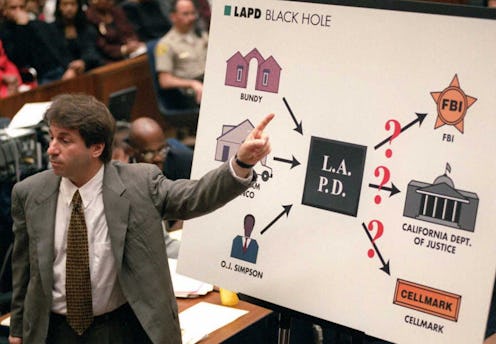News
The Connection Between Steven Avery & O.J.'s Cases
The FX drama that has brought the O.J. Simpson murder trial back to life has done a great job of showcasing America's obsession with the "trial of the century." More than 150 million Americans tuned in for the verdict in 1995. Fast-forward 21 years, and America is fascinated with another real-life crime story: Steven Avery's conviction for the murder of Theresa Halbach. Comparisons have been made before, but there's more connecting the O.J. case and Making a Murderer than murder, fame, and a 10-part television miniseries. It's DNA and the Innocence Project.
The People v. O.J. Simpson: American Crime Story does a good job of showing how Los Angeles' delicate race relations in the '90s became a huge part of Simpson's defense. Johnnie Cochran’s courtroom performance and the timing so close to the Rodney King riots helped seal Simpson's acquittal. But there was another key part of the defense strategy: discrediting the DNA evidence. Robert Shapiro, O.J.'s first defense attorney, quickly recruited two DNA experts to the "dream team" of lawyers to pick apart the way the samples were collected, and the defense even suggested that the evidence was planted.
Those experts were Barry Sheck and Peter Neufeld. They're the co-founders of the Innocence Project, an organization that works to exonerate the wrongfully convicted through DNA testing and promote public policy to reform the criminal justice system. This is the group that Steven Avery reaches out to in Making a Murderer, hoping they'll take his case. His lawyers, Jerry Buting and Dean Strang, weren't able to use DNA to acquit Avery, but maybe more seasoned experts could have done so. Avery's new lawyer, Kathleen Zellner, keeps implying that it may exonerate him.
But Avery is not just loosely connected to the Innocence Project. An associated organization, the Wisconsin Innocence Project, used DNA evidence to exonerate Avery from a prior rape charge, for which he spent 18 years in prison. (Avery was in the process of suing the Manitowoc County Sheriff's department for this when he was arrested over Halbach's death.) The Project was able to match DNA from hairs taken at the scene of the rape to a convicted felon who bore a striking resemblance to Avery.
Speaking nearly 20 years after the Simpson case, Sheck explained his role in the case. The goal was not to undermine all DNA evidence — he advocates using it to exonerate people. The issue was the way the LAPD collected it:
It was a watershed case, but not in ways that people suspect. We did not challenge the underlying reliability of DNA testing methods; we attacked the way that evidence was gathered and processed. We had a 21st century technology and 19th century evidence collection methods.
Sheck said that the use of DNA evidence for exoneration came about largely after the Simpson trial brought DNA evidence into public discourse. After the trial, he worked with one of the prosecuting attorneys to come up with a best practices guide to collecting DNA evidence from the scene, and laws were passed to allow post-conviction DNA testing.
Sheck has also said that the Simpson trial muddied the waters for the Innocence Project's messaging on prosecutorial and police misconduct, the unreliability of confessions, and more problems in the criminal justice system that come to light when DNA proves a convicted criminal was in fact innocent. There was an upside, though:
There were, frankly, uses that can be made of celebrity. After watching this trial, people understood that we had this technology in forensic matters. People did pay attention. Prosecutors and law enforcement took it very seriously. Fame is a good thing to have sometimes if you can put it to good use. The Innocence Project benefited from that.
It's too early to say whether it will be put to good use in Avery's appeals. But if so, it just may become a future season of American Crime Story.
